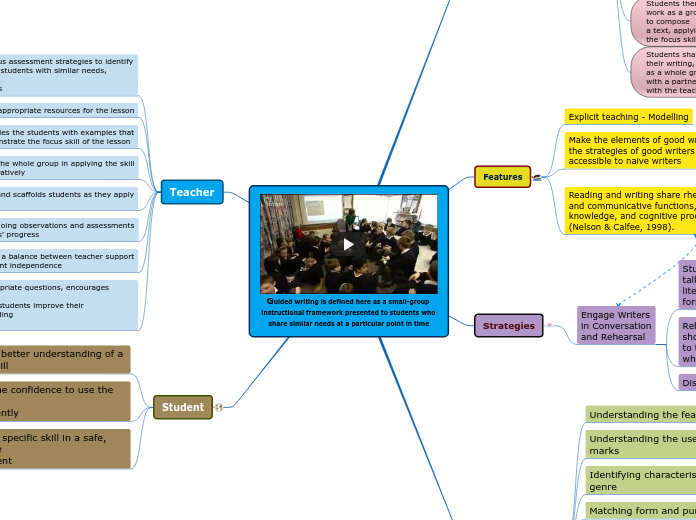Guided writing is defined here as a small-group instructional framework presented to students who share similar needs at a particular point in time
Guided Writing Lesson
During the
first part of
the lesson,
students are
immersed in
the focus skill
through
examination
and discussion
of models.
Teacher then
guides students
to write their
own text
independently,
applying the
focus skill.
Students then
work as a group
to compose
a text, applying
the focus skill.
Students share
their writing,
as a whole group,
with a partner, or
with the teacher.
Features
Explicit teaching - Modelling
Make the elements of good writing and the strategies of good writers visible and accessible to naive writers
Frequency depends on needs of the students
Reading and writing share rhetorical and communicative functions, knowledge, and cognitive processes (Nelson & Calfee, 1998).
Reading and Writing requires the expansion of children's oral language resources and the application of these competencies to understanding and constructing texts within a variety of genres.
Strategies
Engage Writers in Conversation and Rehearsal
Students rehearse new ways of talking about topics of interest using literate and increasingly complex forms of language.
Rehearsal of language structures should be explicit and well connected to the type of text and topic about which students are currently writing.
Discussion and Teacher Explanation
Teaching Points
Understanding the features of text
Understanding the use of quotation marks
Identifying characteristics of a genre
Matching form and purpose
Using more descriptive language
Writing complete sentences
Creating a clear beginning, middle,
and end
Writing a paragraph
Elements of writing (e.g., voice,
sentence fluency, word usage)
Writing a research report
Teacher
uses various assessment strategies to identify
a group of students with similar needs, abilities,
or interests
chooses appropriate resources for the lesson
provides the students with examples that
demonstrate the focus skill of the lesson
leads the whole group in applying the skill
cooperatively
monitors and scaffolds students as they apply
the skill
makes ongoing observations and assessments
of students’ progress
maintains a balance between teacher support
and student independence
asks appropriate questions, encourages dialogue,
and helps students improve their understanding
of the skill
Student
develop a better understanding of a specific skill
develop the confidence to use the skill
independently
work on a specific skill in a safe, supportive
environment
